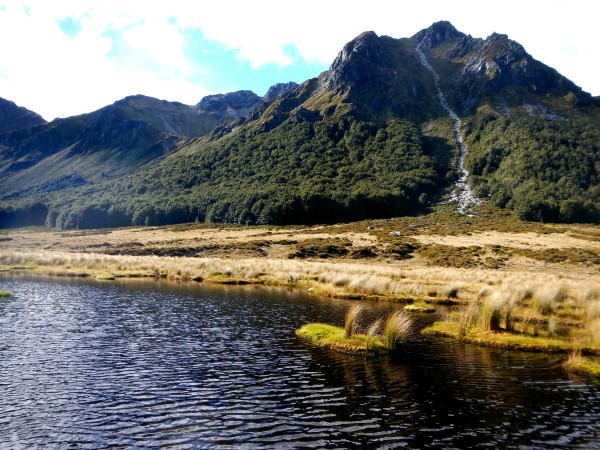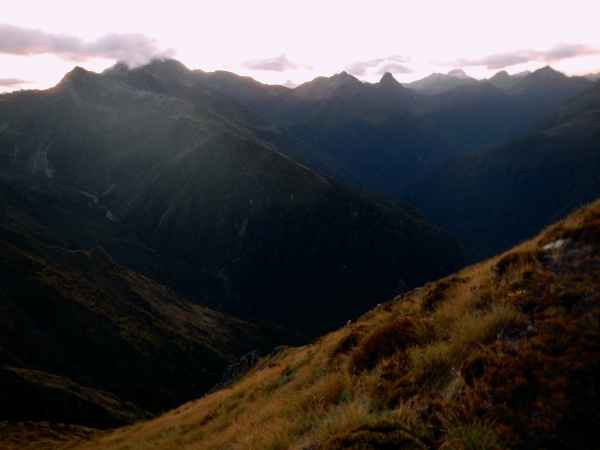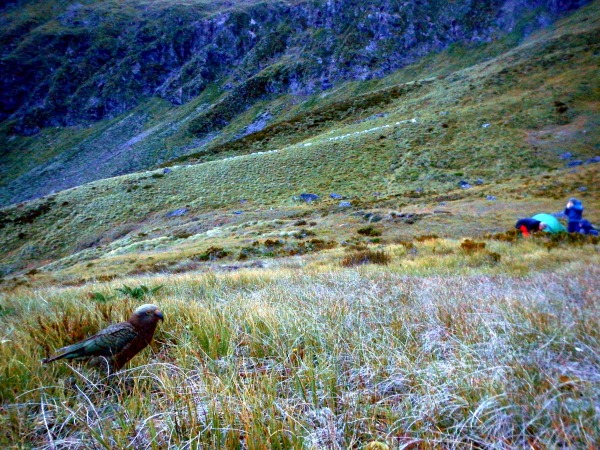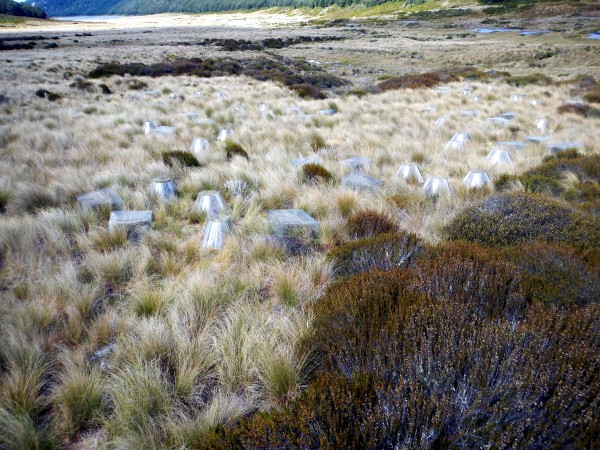My most recent field expedition was to Takahe Valley; a place with an interesting conservation narrative, beautiful scenery, and a fantastic place to do research.
I went to Takahe Valley March 7th – March 10th with along with two Landcare colleagues and another PhD student. Our purpose was to assist with end of the summer field data collection.
Those of you well versed in your New Zealand native birds will recognize the name takahe (Porphyrio hochstetteri). The species was thought extinct when the last 4 known individuals were captured and killed in 1898. However, Geoffrey Orbell rediscovered a remnant population of the birds in a place isolated from human activities near Lake Te Anu (Takahe Valley) in 1948. Concerted conservation efforts since rediscovery have resulted in relatively successful recovery. The Fiordland National Park was created to ensure them a safe home, and deer control is carried out within the park to reduce competition for food. The wild population estimate as of 2013 is 263.

A takahe in captivity. Phtoto by New Zealand Department of Conservation (http://blog.doc.govt.nz/2014/12/01/takahe-finds-love-te-anau/)
I wasn’t able to see any of these beautiful birds (locally “blue chickens”), but I was able to see signs of their presence including well traveled tracks, digestive remains, freshly munched tussock grass, and tracks. Hopefully next time I will be able to sneak a peak!
I was able to see some other charismatic birds though including a Kea (Nestor notabilis), NZ rock wren (Xenicus gilviventris), rifleman (Acanthisitta chloris), and tomtit (Petroica macrocephala).
The Fiordland foothills are composed of gneiss (metamorphosed from mostly granite and diorite). Apparently this is some of the oldest rock in NZ, originating from the Ordovocian period. The valleys and basins were etched through glacial erosion during the last ice age. Alpine areas have exposed rock or scree substrate, while basins soil is composed of podzolised gley and organic soils. The vegetation in our valley ranged from sub-alpine herbs up on the exposed rock and scree at the valley ridges to wetland species down in the basin. Beech forests and tussock grasses can be seen covering and deferentially partitioning large swaths of the valley.

Tussock grass vegetation dominates portions of the basin, as well as some portions of the lower and upper walls, of the valley. Forest dominates most of the midsection.

We camped partially up the valley, at the head wall. This area has some tussocks but also some sub-alpine herbs due to the higher elevation and some wetland plants from the the head water flow.

The head wall ridge. This area has exposed rock and screes, mostly dominated by sub-alpine plants with some small tussocks.
The main purpose of our trip was research. There are transects of tussock grasses here that have been measured for over a decade, investigation the masting events of the tussocks (Chionochloa sp.). Masting is the phenomena of some plants to usually not produce many flowers/seeds most years, but every few years they will all create massive amounts of flowers/seeds. In North America most oak trees (Quercus sp.) display some level of masting.
A feather’s fate; only to drift on the low breeze; never to fly again
Another component of the research is to investigate the interacting influences of anticipated climate change, increasing soil N, and increasing soil C on tussock growth as well as reproduction. Climate change is simulated by putting translucent plastic around the bases of the tussock (creating a mini green house gas effect). Soil N is increased by adding fertilizer. Soil C is increased by sprinkling sugar on the plots. We had to count the number of tillers (stems) on every experimental plant (counts ranged from ~30 to ~800). The cages are to protect the tussocks from takahe, as this is their favorite food.
We also collected invertebrate data for each plot to see if the treatments (temperature * N * C) had an influence on invertebrate diversity or community composition.
Me emptying invertebrates from pitfall traps. These traps passively capture insects by trapping them in a cup filled with death liquid.
It was a fantastic trip filled with good company, good weather and goo food. I eagerly await my next expedition into Takahe Valley!
-Greg





March 16, 2015 at 10:04 am
I apologize for the sub par photograph quality. I am trying to find a way to improve this for future posts. Until then, you can enjoy my pictures in all their glory on my Flickr page (https://www.flickr.com/photos/naturenaught/).
-Greg
LikeLiked by 2 people
March 16, 2015 at 4:05 pm
Thanks for the report, Greg. It was very interesting.
LikeLike
March 17, 2015 at 8:04 am
Thank you for checking it out! I appreciate you keeping up with me and hope that I’ve helped you learn a little more about New Zealand. Hope all is well.
LikeLiked by 1 person
March 16, 2015 at 6:43 pm
Love the feather pic! Keep up the good work buddy!
LikeLike
March 17, 2015 at 8:06 am
Thanks John! I’m glad you liked my “reflecting pool”. I think about Minneapolis often and miss living in the city sometimes. I hope all is well with the family. Please give Erin my regards, and get over here already!
LikeLike
March 16, 2015 at 10:21 pm
Greg, thank you so much. I don’t understand most of it but I appreciate it so much. Keep trying to educate me.
LikeLike
March 17, 2015 at 8:08 am
Hello grandma. I’m glad that you found it enjoyable. Perhaps the most important messages here are that I’m happy, doing what I love to do, and take sweet pictures. If nothing else, I hope to just demonstrate to people how beautiful the world is, every day is an adventure, and there is so much to explore.
LikeLiked by 1 person